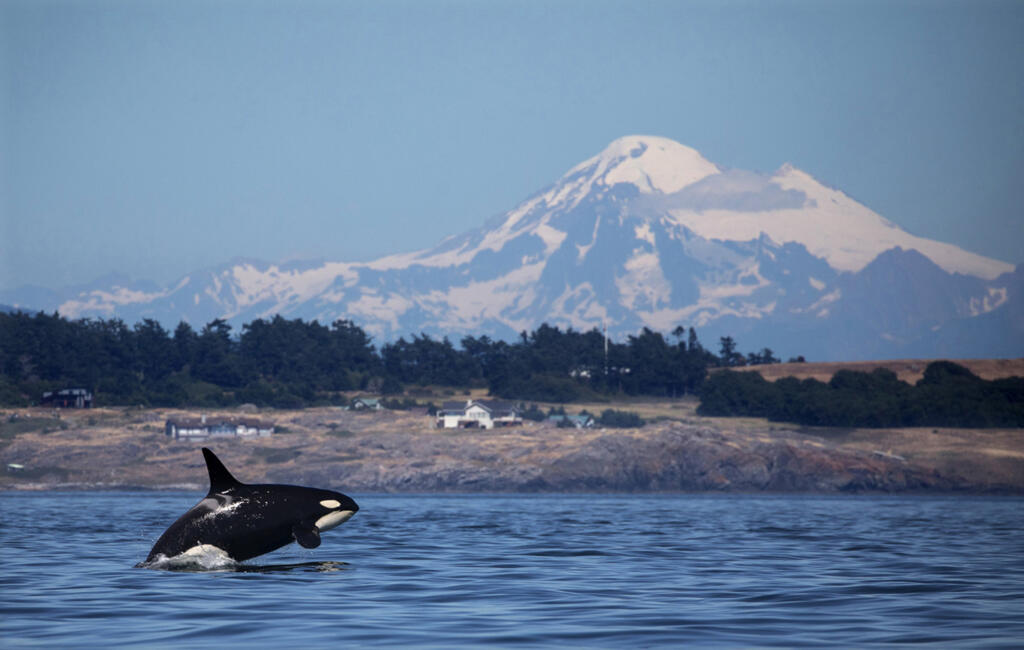SEATTLE — Amid human made barriers to finding adequate food, hearing or communicating with each other, the endangered southern resident orcas may have seen an increase in the prevalence of skin disease, according to a new study.
The peer-reviewed research published in the Public Library of Science on Wednesday suggests 99% of the orcas studied had photographic evidence of skin lesions. Researchers evaluated photos from nearly 20,000 orca sightings from 2004 to 2016, finding that lesions — often gray patches and gray targets on the orcas’ skin — generally became more prevalent over time.
Scientists aren’t sure of the cause or the health implications of the lesions but are concerned about the potential relationship between the lesions, declining body condition, health and immune system strength in a struggling population.
Only 73 southern resident orcas remain, according to the latest census.
That’s one of the lowest population counts among the J, K and L pods of whales since 1974, when 71 orcas were counted following a live-capture era in the 1960s.
The Center for Whale Research, which has been conducting photographic identification surveys of southern resident orcas in the Salish Sea since the 1970s, shared the photos for the study. The images revealed six types of lesions.
The most common were gray patches, varying in size and shape, visible in about one third of orca sightings, and gray targets, two-toned lesions seen in about 25% of orcas studied. Researchers also tracked erosions or indentations in the orcas’ skin and other forms of discoloration.
Researchers did not find any correlation between the lesions and deaths. The lesions are more likely a symptom than a cause of the orcas’ plight, said Joseph Gaydos, science director of the SeaDoc Society and the study’s lead author.
“We don’t think these lesions are what’s causing the decline,” Gaydos said. “We’ve got other stuff we got to worry about and got to fix; but when you start to see something that may be related to the immune system, appearing more and more often, that tells us that: oh my gosh, there’s a good chance things are actually getting worse.”
The lesions could point to additional environmental or outside stressors on the animals that are suppressing their immune systems. It heightens the importance of investing in salmon recovery, reducing boat disturbance and other factors that impact the southern residents’ ability to survive, Gaydos said.
Researchers hypothesized that the increases in gray patches and targets may have been tied to degraded coastal environments, climate change and higher levels of solar ultraviolet radiation known to exacerbate some diseases. But they do not have enough data to support the assumption, according to the study. The scientists also hypothesize that the most plausible explanation is an infectious agent — bacteria, fungus or viruses.
The research was the first crack at looking at overall health of the orcas based on their skin condition, said Deborah Giles, a co-author of the report and research director at nonprofit Wild Orca. Researchers with different areas of expertise came together to help evaluate the population’s health and review the photographs.
Skin lesions have been noted for quite awhile, said Brad Hanson, a wildlife biologist for the National Oceanic and Atmospheric Administration and co-author of the study, but no one had closely studied their occurrence.
The study was a noninvasive way of examining the orcas and helped build out the southern residents’ individual health records, Giles said. The study should prompt future research about the cause of the lesions, and may encourage researchers to take a closer look at orcas with other potential health complications.
“What’s happening with the southern residents is indicative of what’s happening overall to everything below that, including us,” Giles said.
The report was a collaborative effort among scientists from the SeaDoc Society, Center for Whale Research, British Columbia’s Animal Health Center, NOAA’s Northwest Fisheries Science Center, San Diego Zoo Wildlife Alliance, SeaWorld Parks and Entertainment, the Vancouver Aquarium, Wild Orca, and others.
In 2005, the southern residents were listed as endangered under the Endangered Species Act and a recovery plan was finished in 2008.
In 2015, they became one of NOAA’s “Species in the Spotlight,” an effort to raise awareness and save “the most highly at-risk marine species.”
Generally, the southern residents are struggling to survive in the face of at least three threats: lack of Chinook salmon in their foraging range, pollution and underwater noise that makes it harder for them to hunt.
Recent research revealed that with fewer Chinook salmon to eat, the southern resident orcas are visiting the San Juan Islands, their traditional summer home, less often. Researchers documented a 75% drop in reported sightings of the southern residents from 2004 to 2020 around the archipelago. That corresponded with a 50% decline in available Chinook, the orcas’ favorite food, from British Columbia’s Fraser River.
That study comes alongside recent research that found the southern resident females have less hunting success than their neighbors up north, and that a shrinking, increasingly inbred population of southern residents could be plummeting toward extinction.
“I think there’s more questions than there are answers, and we need to continue with research to better understand what’s happening and ultimately what we can do about it,” Giles said.



